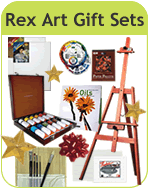Being in Control at the Easel: Evaluating Our Work
Regardless of subject, medium, technique, or level of experience, all painters unavoidably work with space, line, value, and color. By controlling visual relationships, we create images on things that won’t actually be on the picture surface at all: form, depth, separation, texture, and varying degrees and types of light. Depicted accurately, these elements magically produce convincing illusions of subject matter.
Art has always been a means of communication. It’s a “show and tell” process with the telling being most important. We zoom in on what we personally discover to be the most important aspect of our subject, and then we relate principles of art to increase the effectiveness of communicating our unique emotional rapport with that something special.
Technically, we must understand exactly how end results are achieved or why they fail. It’s those visual relationships that make the difference.
We must see and know our subject. Guesswork probably destroys more compositions than any other factor. Good enough usually isn’t. We cannot possibly produce work with artistic merit until we focus intently on principles of art rather than merely attempt to duplicate what we see “just like it is,” leaving nothing out, but putting nothing in of our own choice. I believe that it is necessary to recognize, evaluate, and control eight major components of every painting.
Impact
This is the all-important first glance impression when looking at our own work
or that of others. It’s often called the WOW factor. If the finished
work doesn’t take our breath away or require a double take, it probably
won’t make much of an impression on others either.
Clarity
A painting should be easily understood. Its message should be as obvious as
the melody rising above countless other supportive orchestral notes, or an
easy to follow story line in well-written literature.
Composition
The picture surface should generally be divided into just a few explicit measurements
and shapes, while satisfying the universal human need for simplicity, harmony,
and variety.
Design
This is the selection and relative positioning of subject matter or objects
to fit into the compositional pattern and enhance illusions of form, depth,
separation, and texture by showing varying degrees and types of light.
Values
Each visible object and surface reflects light. Light is what we depict. Only
when the light we see is described accurately can the illusions of subject
matter appear.
Edges
Edges are selected and controlled so as to be sharply defined, soft, or unseen.
Edges are what hold the composition together and are controlled to add emphasis
to a focal point.
Color
Variations of color temperature, lightness, darkness, and brilliance are utilized
to attract the eye, subdue importance, and clarify types of light, nearness,
or distance.
Line
Horizontals, verticals, diagonals, straight or curved lines, and calm or active
lines should vary in length, activity, and direction, while easily leading
the eye toward a center of interest.
Don Foster
- Green art supply product
- Drop Ship - Item is shipped from manufacturer
- Oversized - Additional shipping may apply
- Item Ships via Truck - Additional shipping will apply
*Free Shipping Offer valid for single package non-oversized shipments over $100.00 (after all applicable coupons have been applied) and under 20 lbs. within the 48 contiguous United States only. All other areas must pay shipping and handling charges. Exclusions apply. Orders for stretcher bars, cradled wood panels, stretched canvas, flammable items, closeout or discontinued merchandise cannot qualify for our free shipping promotion. We reserve the right to ship via the carrier of our choice.
Copyright © 1997 - 2023 by Rex Art Co. All rights reserved. Prices shown are in U.S. Dollars. Prices are subject to change.


